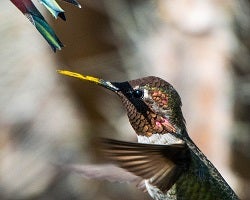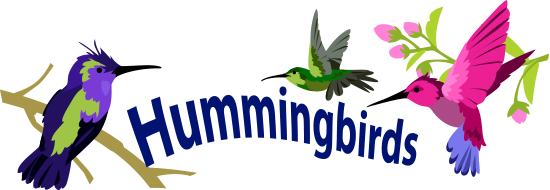Pollination

Flowers don't provide hummingbirds with delicious nectar out of kindness. Hummingbirds are pollinators. This means that when a hummingbird comes to a flower to get a meal, it brushes against the male parts of the flower and gets pollen grains all over itself. When it buzzes off to the next flower, the pollen rubs off onto the female parts of the new flower. In this way, hummingbirds help flowers make new seeds and the next generation of flowers.
Evolving Together
Both flowers and hummingbirds benefit when a hummingbird comes by for a drink. As a result, species of hummingbirds and species of flowers often evolve together, a process called co-adaptation.
Different species of hummingbirds have differently shaped beaks that evolved to allow them to drink from a certain kind of flower. In return, the flower species it feeds from has evolved to produce nectar especially tasty to hummingbirds and to prevent bees and other animals from stealing it.

Where Did They Come From?
Unfortunately, scientists don't know much about how the first hummingbird evolved. Hummingbird bones are so small and fragile that they usually don't last long enough to become fossils.

Researchers have dated the oldest hummingbird fossil to thirty-five to thirty million years old. Amazingly, it was found in Germany, not America. The first hummingbirds may have evolved in Europe, moved to the Americas and then died out in Europe.
Scientists studying the DNA of hummingbirds suggest that the newly arrived American hummingbirds first reached South America, where they then began to split into hundreds of species and move north. These splits began around 22 million years ago, but the evolution of hummingbirds into new species continues today.
Images via Wikimedia Commons. Violet-crowned woodnymph image by Joseph C Boone.
Read more about: Hummingbirds
Bibliographic details:
- Article: Hummingbird Evolution
- Author(s): Dr. Biology
- Publisher: Arizona State University School of Life Sciences Ask A Biologist
- Site name: ASU - Ask A Biologist
- Date published:
- Date accessed:
- Link: https://askabiologist.asu.edu/hummingbird-evolution
APA Style
Dr. Biology. (). Hummingbird Evolution. ASU - Ask A Biologist. Retrieved from https://askabiologist.asu.edu/hummingbird-evolution
Chicago Manual of Style
Dr. Biology. "Hummingbird Evolution". ASU - Ask A Biologist. . https://askabiologist.asu.edu/hummingbird-evolution
Dr. Biology. "Hummingbird Evolution". ASU - Ask A Biologist. . ASU - Ask A Biologist, Web. https://askabiologist.asu.edu/hummingbird-evolution
MLA 2017 Style

Vibrant colors, like on this violet-crowned woodnymph, have evolved to help males win mates.
Be Part of
Ask A Biologist
By volunteering, or simply sending us feedback on the site. Scientists, teachers, writers, illustrators, and translators are all important to the program. If you are interested in helping with the website we have a Volunteers page to get the process started.

